Recycling-oriented resource usage
In addition to targets for overall waste reduction, we have also set goals for reduction of plastic waste which are major sources of marine pollution and water consumption, and will work to achieve a circular economy through promotion of environmentally friendly business activities and joint development of recycling technologies.
Mid-Term Environmental Goals 2030
| Material issues | KPIs | Goals (Base year 2019) | 2024 results |
|---|---|---|---|
| Recycling-oriented resource usage (Resource conservation/waste management) |
Industrial waste reduction | 5% reduction by 2025*1 10% reduction by 2030*1 |
11.6% reduction |
| Plastic waste reduction | 5% reduction by 2025*1 10% reduction by 2030*1 |
14.3% reduction | |
| Water resource conservation (water withdrawn) | 15% reduction by 2030*1 | 21.7% reduction |
- *1 Per total floor area (Excluding leased properties)
Reduction of Industrial Waste
Generation of waste materials (industrial waste and valuable resources) in 2024
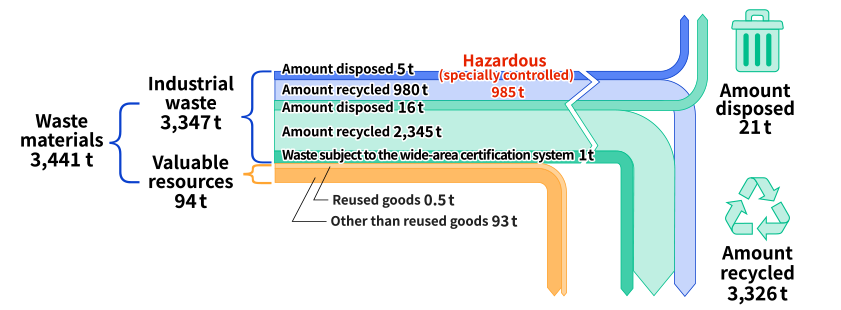
In 2024, the amount of waste materials was 3,411 tons. In order to make effective use of resources, we are actively working to turn waste materials into valuable materials and were able to convert 94 tons of waste materials into valuable resources, thereby reducing industrial waste emissions. The breakdown of valuable resources was 0.5 tons for reuse of research equipment and 93 tons for recycling of plastics, metals, and other materials. Details on each of these items of industrial waste are explained below.
Change in Industrial Waste Emissions
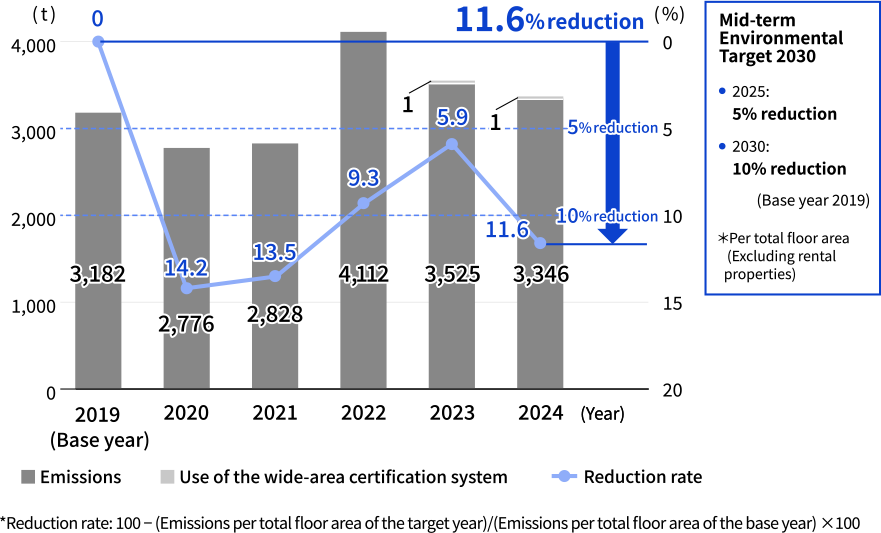
In 2024, industrial waste emissions increased by 5.2% over the base year and decreased by 5.1% from the previous year, to 3,347 tons, of which 1 ton was emitted through the wide-area certification system. In 2022, emissions increased significantly due to the disposal of buried waste at the Fujieda Plant. In the following year, 2023, emissions were expected to increase due to the closure and relocation of the Kamakura and Fuji Gotemba Research Laboratories. However, we controlled the increase in emissions thanks to effective use of resources, such as the active reuse of research equipment as valuable resources and the recycling of plastics and metals.
On the other hand, emissions per total floor area were 9.3 kg/m2, down 11.6% from 10.5 kg/m2 in the base year and up 0.6 kg/m2 from the previous year. We will continue to promote waste reduction efforts by reviewing our waste generation process while promoting proper disposal of waste.
Change in Plastic Waste Emissions
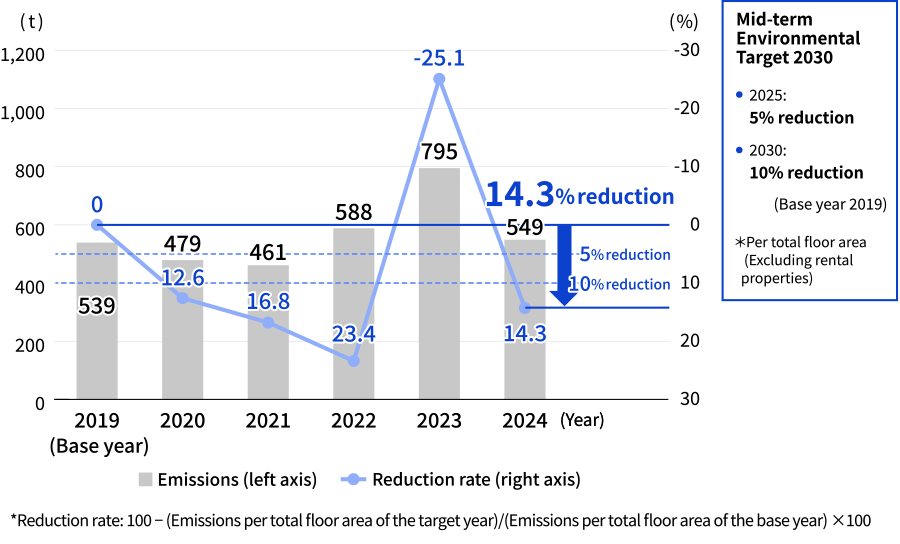
Plastic waste emissions in 2024 were 549 tons, up 1.9% from the base year, and emissions per total floor area were 1.43 kg/m2, down 14.3% from 1.8 kg/m2 in the base year. The temporary increase in plastic waste emissions in 2023 was due to reduction in total floor area and the temporary rise in emissions resulting from the closure of the Kamakura and Fuji Gotemba Research Laboratories. While the concept of the circular economy is currently gaining ground, marine pollution caused by plastics is a serious social issue, and we will work to reduce plastic waste as well as overall waste.
Change in Waste Recycled and Recycling Ratio
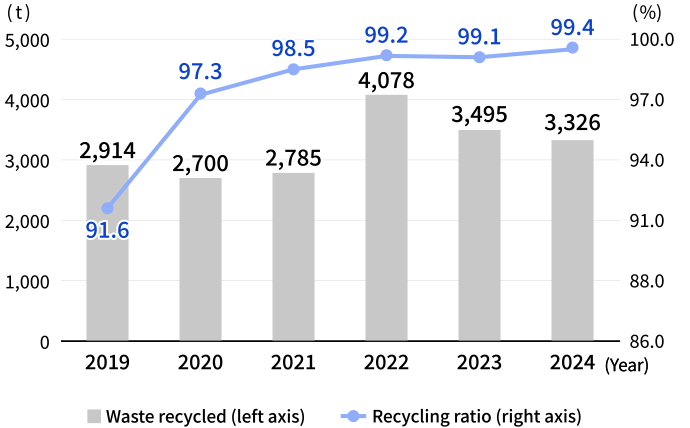
In 2024, recycled waste amounted to 3,326 tons out of the 3,347 tons of industrial waste generated, for a recycling rate of 99.4%. The Ukima Plant, Fujieda Plant, Utsunomiya Plant, and Chugai Life Science Park Yokohama achieved zero emissions.
Change in Amount of Industrial Landfill Waste, Final Disposal Rate
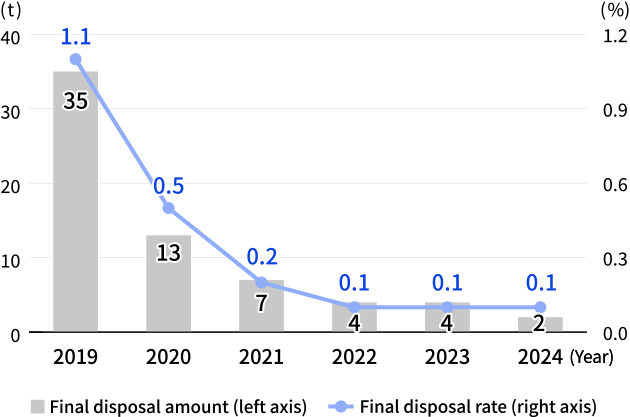
Final disposal amount: Calculated by multiplying the disposal amount for each industrial waste by the respective incineration coefficient
In 2024, the final disposal amount was only 2 tons and the final disposal rate was 0.1%. We will continue our efforts to reduce industrial waste as well as to improve the recycling rate and reduce the final disposal amount.
Proper Disposal of Waste Materials
Once a year, Chugai holds conferences for persons in charge of waste, mainly those at plants and research laboratories.
The staff in charge shares information on revisions to the Waste Management and Public Cleansing Act and proper disposal, to ensure thorough compliance.
In addition, we have set a goal to conduct 100% or more on-site inspections of all contracted waste disposal companies during the three-year period from 2024 to 2026, which is an effort requirement under the Waste Management and Public Cleansing Act. In the first year of this initiative, 2024, we conducted inspections at 18 of the 48 contracted waste disposal companies.
We will continue our efforts to reduce the risk of illegal disposal of waste.
Initiatives involving Chugai product countermeasures to address reduction of environmental load
There is a common awareness that in the field of resource recycling, the impact of marine plastics on ecosystems has become an urgent, global-scale issue, and discussions are being held at a variety of international conferences, including the G20 and the United Nations. To address this plastic litter problem, the G20 Osaka Summit held in June 2019 shared the “Osaka Blue Ocean Vision” which aims to reduce additional marine plastic litter to zero by 2050. In May 2019, Japan formulated its Resource Circulation Strategy for Plastics, based on the concept of “3Rs + Renewable” (4Rs), established specific numerical milestones for reducing the use of plastics, and is engaged in a variety of initiatives.
In the use of recycled/renewable resources, one of the material issues in the Chugai Group’s Mid-term Environmental Target 2030, we have established the goal of reducing the emissions of plastic waste per total floor area by 5% in 2025 and by 10% in 2030, compared with 2019, part of our effort to reduce the plastic waste emitted by our facilities.
| Packaging Material | Measures | |
|---|---|---|
| Primary packaging | PTP | Thin plastic film used Change to biomass plastics (gradual switch began in 2023)  [Biomass plastic identification mark] |
| Glass bottles | Lightweight bottles used | |
| Plastic bottles | Change to biomass plastics (gradual switch began in 2023) [Biomass plastic identification mark] |
|
| Secondary and tertiary packaging | Individual boxes | Thin paperboard used Recycled paper used |
| Paper trays | ||
| Cardboard boxes | ||
| Syringe blister packs | Use of recycled plastics (gradual switch began in 2022)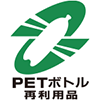 PET bottles |
|
| Aluminum pillows | ||
| Common across packaging materials | Material labeling to encourage recycling | |
In a new initiative in addition to “Reducing” plastic, since 2020 we have been using “Recycled” plastic. In “Renewable,” we are considering switching from petroleum-based plastic materials to biomass plastic derived from plants and other renewable raw materials. This initiative is focused on PTP, aluminum pillows, syringe blister packs and plastic bottles, which are used in particularly large quantities. In 2022, we switched to packaging materials containing recycled plastic in aluminum pillows and syringe blister packs for some products, and in 2023, we began to use biomass plastic in some of our PTP and plastic bottles. We will continue to consider technologies with the aim of using packaging materials containing eco-friendly plastics in all of our products by 2030. Please see the link below for details.
Container and Packaging Usage, Recycling Consignment Application (2024 results) (tons)
| Container and Packaging Usage | Recycling Consignment Application | |
|---|---|---|
| Paper | 21.8 | 0.4 |
| Plastics | 71.8 | 20.9 |
| Glass (brown) | 8.9 | 2.2 |
| Total | 102.5 | 23.4 |
Reduction of water consumption (water withdrawal) and prevention of water pollution
Change in Water Consumption (water withdrawal)
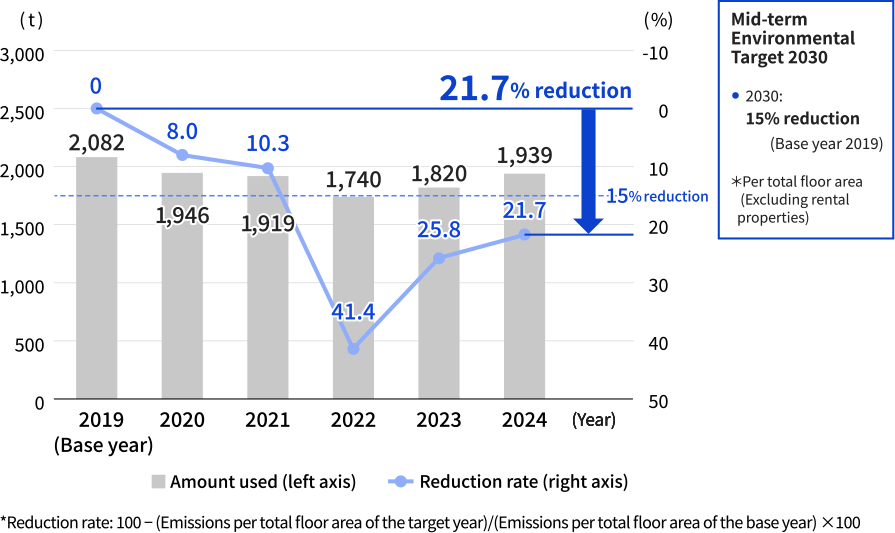
In 2024, water withdrawal was 1,939 tons, down 6.9% from the base year and up 6.5% from the previous year, and in terms of water withdrawal per total floor area, it was 5.4 kg/m2, down 21.7% from the base year, thereby maintaining the achievement of our Mid-Term Environmental Goal 2030 of a 15% reduction. The increase in water withdrawal in 2023 is attributed to the fact that the Kamakura and Fuji Gotemba Laboratories were in operation until their closure in June and July 2023, while the increase in water withdrawal per total floor area is attributed to the decrease in total floor area due to the closure of both laboratories.
Total BOD, Nitrogen and Phosphorus
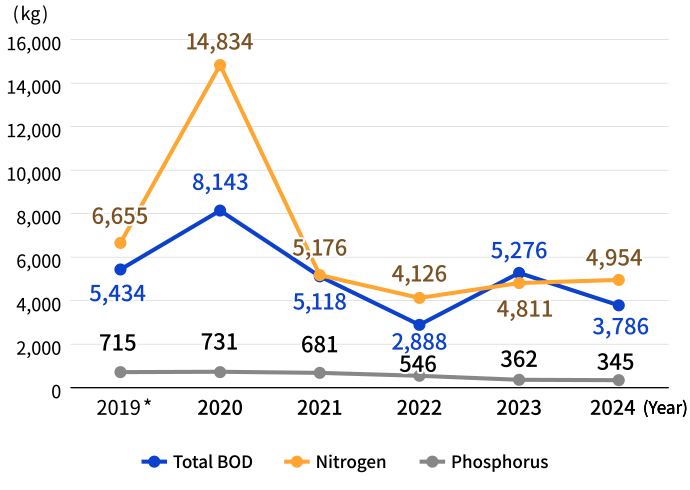
* An error was found in the fiscal 2019 numbers for nitrogen and phosphorus; those values have been revised.
(Nitrogen: 4,444 kg → 6,655 kg) (Phosphorus: 647 kg → 715 kg)
Total BOD in wastewater decreased by 1,490 kg to 3,786 kg, nitrogen increased by 143 kg to 4,954 kg, and phosphorus reduced by 17 kg to 345 kg, compared to 2023. In accordance with the Water Pollution Control Act and prefectural ordinances, wastewater is treated at specific facilities and discharged into public waters after confirming that it complies with wastewater standards.

